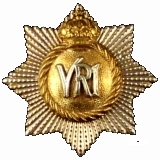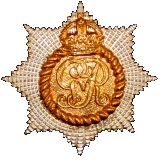
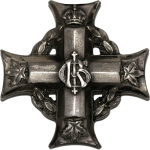
The First World War
Soldiers and Non-Commissioned Officers
of The Royal Canadian Regiment
477550 Sergeant Walter Lowe, M.M.
By: Captain Michael O'Leary, The RCR
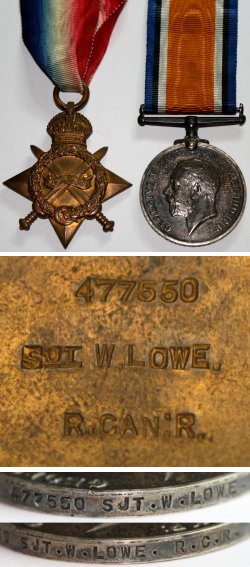
Two of the First World War medals awarded to 477550 Sergeant Walter Lowe, M.M., The R.C.R.
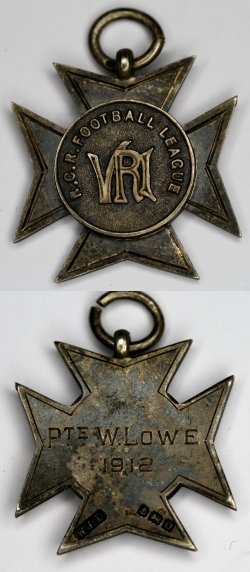
Regimental sports medal for the R.C.R. Football League. Awarded to 9508 Pte Walter Lowe, The R.C.R., in 1912. (Size of cross; 29 x 29 mm.)
Walter Lowe was born at Tramere, Cheshire, England on 5 September 1890. In 1901, according to census records, Walter (10) lived with his widowed mother Margaret (39), older sister Lillian (18), brother Herbert (17) and little sister Edith (7) at Little Mill House, Midgley, Luddenden Foot.
In 1903, Walter Lowe was one of the first boys to join the Luddenden Foot Boys Brigade Company. With the Boys Brigade he was active in drumming, football and gymnastics. At the time, the family was living at Canal Bank, Luddenden foot. Walter Lowe remained with the Boys Brigade and in 1909 became an officer. He left the Boys Brigade in January 1911 when he departed for Canada.
On 6 February 1911, at Halifax, Nova Scotia, Walter Lowe joined the Canadian Permanent Force, attesting for three years service with the Royal Canadian Regiment (The RCR). He was 20 years of age at the time and stated his trade as millhand. Lowe declared his next of kin to be his mother, who was still residing at Luddenden Foot, Yorkshire. At 1020 a.m. on 6 February, Lowe made the required oath swearing allegiance to His Majesty before the Commanding Officer, lieutenant Colonel Septimus Denison (CMG and MiD* - South African War). Lowe was given the regimental number 9508.
In the 1911 Canadian Census, soldiers of The RCR living in barracks in Halifax were all recorded as "lodgers". Walter Lowe and his brother Herbert, who was seven years older, were both recorded as soldiers of The RCR during that census.
Walter Lowe proved himself to be proficient as a soldier of the Regiment, and he was appointed to the rank of Lance Corporal on 30 August, 1913. On 6 February 1914, 9508 Lance Corporal Walter Lowe reengaged for a further three years service with The RCR.
Walter Lowe served in Bermuda with the RCR from September 1914 to August 1915. The Regiment was despatched to the island to serve as a garrison battalion, relieving the 2nd Battalion, Lincolnshire Regiment. The Regiment returned to Halifax and, over a week between the 17th and 24th of August, every officer and soldier was required to reattest for overseas service before continuing to England, and then France. Lowe's promotion to Corporal was confirmed on 1 January 1915 while the Regiment served in Bermuda.
A single soldier, 5 foot 8 inches in height, with fair skin, grey eyes and light coloured hair, Lowe attested for overseas service with the Canadian Expeditionary Force as a soldier of The Royal Canadian Regiment at Halifax, Nova Scotia on 25 August 1915.
Walter Lowe he was appointed to the rank of Lance Sergeant on 1 October followed quickly by a promotion to Sergeant, which was confirmed on 5 October 1915.
On 2 November 1915, Walter Lowe embarked for France with his regiment. His file records no other individual activities until late March, 1916, when on the 21st of the month, Sergeant Lowe was granted nine days Leave.
Walter Lowe is mentioned in the Regiment's history during operations at Mount Sorrel in early June 1916:
Throughout the engagement up to this time, the work of the non-commissioned officers of the Regiment had been of the highest order. In reporting upon their efforts later, officers found difficulty in choosing those deserving special mention, but a number carried out their duties in a manner so outstanding that mention of their names was inevitable. Among such were: Company Sergt.-Major A. A. Giles, whose leadership set a splendid example to all under his command; Corporal H. Brealey, whose bravery inspired his section during the heaviest stage of the German attacks; Sergt. J. Hoban, who went over the parapet in daylight and captured a German scout; Sergt. S. Flansberg, whose gallantry in the action was continuous; Sergt. A. Hunt, who similarly displayed bravery and devotion to duty during the whole engagement; Sergt. W. Lowe, who supplied a number of advanced posts with rations under heavy fire; Lance-Corporal P. Ball and
During late October 1916 Sergeant Lowe was employed as an instructor at the Canadian Corps Bombing School, Pernes. On 28 October he was severely injured in the premature explosion of a No. 5 Mills hand grenade as it left the throwers hand. The thrower, Lt R.R. Insole of the 2nd Canadian Pioneer Battalion, was also wounded, injuring his right hand.
A Court of Inquiry was convened by the Acting Commandant of the Bombing School, Lieut. H.C.H. Brayfield, the minutes if which follow:
PROCEEDINGS OF A COURT OF ENQUIRY assembled at the Commandant's Office Canadian Corps Bombing School, PERNES on October 28th, 1916, by the order of Lieut. H.C.H. BRAYFIELD, Acting Commandant Canadian Corps Bombing School to enquire into the accident which happened at the Canadian Corps Bombing School on October 28th, 1916 and resulting in the wounding of Lieut. R.R. INSOLE, 2nd. Canadian Pioneer Battalion and No.477550 Sgt. LOWE, W. Royal Canadian Regiment.
PRESIDENT.
MAJOR F.L. STEPHENS, 14th Canadian Battalion
MEMBERS
Lieutenant A.PRYCE, 27th Canadian Battalion
Lieutenant J. C. STUART, 26th Canadian Battalion
First Witness.
Lieut. H.C.H. Brayfield, 8th. Canadian Battalion, Acting Commandant, Canadian Corps Bombing School being called states:-"The Commandant, Major O.F Brothers, being absent on leave, I am Acting Commandant. The Standing Orders of the Canadian Corps Bombing School in connection with the throwing of live grenades are the ones followed in our live throwing and these include all Canadian Corps G.643 and amendments. As soon as I was advised of the accident I telephoned for the ambulance. I proceeded towards the scene of the accident and meeting the carrying party close to the dressing station went there with the casualties.
(signed)
Lieut. H.C.H. Brayfield
A/Commandant, Canadian Corps Bombing School.
Second Witness.
Lieut. A.L. PHILPS, 26th. Canadian Battalion, Instructor of bombing at the Canadian Corps Bombing School and temporarily in charge of the throwing of live grenades being called states:- "I was temporarily in charge of No.1 Group, "A" Wing this morning during the throwing of live grenades. The bombs being used were No.5 Mills Hand Grenade and were drawn in boxes from the magazine.
According to School orders the bombs used were inspected by an Officer and the N.C.O. Instructor, this included the inspection of Igniter set, Striker head (two pips), lever, safety pin and they were apparently correct.
Lieut. Insole was in the throwing bay and Sgt. Lowe was round the corner of the T at a distance of 5 feet from the thrower and was protected from the shoulders down.
I was twenty-five yards in rear of the throwing bay in an observation post.
I saw the officer (Lieut. Insole) throw back his hand in the act of throwing and the bomb was thrown but exploded within one foot of the throwers hand.
I saw Sgt. Lowe fall and saw that the thrower (Lieut INSOLE) was wounded in the right hand.
I immediately took steps to furnish first aid and sent for the stretcher bearers and Medical Officer.
I estimate the time between the withdrawal of the safety pin and throwing of the grenade at two seconds.
Immediately after the accident I had both boxes that contained the hand grenades that the throwers were using and also the unused grenades sent to the School Orderly Room.
All instructions contained in the School Standing Orders relating to throwing of live grenades were complied with.
In my opinion the accident was due to the premature explosion of the bomb.
(signed)
Lieut. A.L. Phillips, 26th Canadian Battalion
Third Witness
Lieut. J.A. HARSTONE, 19th Canadian Battalion, attending the Grenade Course at the Canadian Corps Bombing School being called states:- On the morning of the accident about 9.00 a.m. No. 1. Section under Sgt. LOWE proceeded to the throwing area. The party carried two boxes of No. 5 Mills Hand Grenades of which each officer was given two bombs to inspect and detonate. This inspection included Ignition set, striker head, (two Pips) lever, safety pin.
The two bombs that I was preparing for my own use were inspected by Sgt. Lowe before being detonated and I personally saw Sgt. Lowe inspect other's grenades of the party before use. While in the throwing bay myself Sgt. Lowe's position was well out of the throwing bay and well behind the T of the adjoining bay.
Lieut. Insole was the fifth officer to throw. A considerable time elapsed between the throwing of his first and second bomb. I stepped out of the bay and to the rear and then saw Sgt. Lowe immediately behind the T of the throwing bay. I saw the bomb explode just over the top of the parapet
I accompanied Lieut. INSOLE to the Dressing Station and while there he stated that he had had considerable trouble in extracting the safety pin. Lieut. Insole said that he had retained his grip on the bomb and lever until it was thrown and that it exploded immediately on leaving his hand.
During the throwing Lieut PHILPS of the School was in charge.
(signed)
Lieut. J.A. HARSTONE
19th Canadian Battalion
Fourth Witness.
Lieut. R.H. FINLAYSON, 7th. Canadian Battalion, attending the Grenade Course at the Canadian Corps Bombing School, being called states:- I was in the next bay to Lieut. Insole being the next thrower. A little time elapsed between the throwing of the first and second bombs. I heard the Sgt. say, "Now take your time and don't try to throw the bomb at the same time as you pull the pin". I next heard an explosion which seemed right above my head and saw Lieut. Insole rush out, shaking his hand which was covered in blood.
I saw the Sergeant Instructor inspect and supervise the detonating of the bombs taken from the boxes.
(signed)
Lieut. R.H. FINLAYSON
7th. Canadian Battalion
Fifth Witness.
No. 25933 Corporal H. Campbell, Magazine Corporal, being called states:- "The boxes of No. 5 Mills Hand Grenades issued to Sgt. Lowe on the morning of the accident were in the same condition as received from the C.A.P.
(signed)
Corporal H. Campbell
14th. Canadian Battalion
The grenade in question was taken from one of two boxes which were examined by the Court. Box No. 1 marked P.B. & Co. 1915. Box No.2 marked III N.K.S. 1915.
They contained grenades marked as follows D.F. Co. 3/16, K.15, C.A.V. 8/15, H. & B. Ltd. 12/15, H. & T.V. 9/15, C.A.V. 8/16, K 12/1915, K. 1/1916, E.A. Radnol & Co. 8/1916 B, C.A.V. 9/15, J.P.N.S. & S.W. 12/15, K. 12/1915, J.G. 10/15, and on the bottom of one detonator box is "I" over two lines No. 124 over C.A.V. and on the other a triangular insignia, the sides formed by the words Elmbank Foundry Glasgow and in the centre "I" over No. 124.
No labels were attached to the detonator boxes. Although these were issued to the School as new bombs, from their appearance we consider that they were salvage bombs.
FINDING.
The Finding of a Court of Enquiry held on Oct. 28th 1916 at the Canadian Corps Bombing School, to enquire into the accident which happened at the Canadian Corps Bombing School on October 28th 1.9l6 which resulted in the wounding of Lieut. R.F. INSOLE and Sgt. LOWE is that:
(1) That the grenade was a No.5 Mills Hand Grenade.
(2) That the markings on the Grenades, Grenade Boxes and Detonator boxes were as stated in the evidence.
(3) That the instructions followed were the School Standing Orders in which are contained Canadian Corps G.643.
(4) That the grenade had not been tampered with or used prior to the issue on the occasion in question.
(5) That the following parts had been inspected before use and that they were apparently correct; Ignition-set, striker head (two Pips) lever, safety-pin.
(6) That we are unable to obtain evidence as to the fitting of the Ignitor-set into the grenade.
(7) That the lever was held depressed by the hand until the instant of throwing.
(8 ) That the explosion was almost instantaneous with the throwing.
(9) That the time that elapsed between the drawing of the safety pin and the throwing of the grenade is estimated 2 seconds.
(10) That the accident was caused by the premature explosion of a No.5.Mills Hand Grenade.
(11) That all instructions contained in Canadian Corps G.643 were complied with.
(Signed by President and Members of the Court of Inquiry)
Annotated: "I concur with the finding of the Court"
(signed)
Lieut. H.C.H. Brayfield
Acting Commandant
Canadian Corps Bombing School
4 Nov 1916
Following the range accident, Sergeant Lowe was transported to the No. 7 General Hospital at St. Omer, where he died of wounds on 30 Oct 1916. His fatal injury was described as "fractured skull and bomb injury." An index card in Lowe's file described his death as "died of wounds received in action."
Lowe was awarded the Military Medal, which was gazetted in issue number 29805 of the London Gazette 27 Oct 1916. It is possible that he was not aware of the award of his medal before his death on 30 October.
In Lowe's last will and testament, he left all of his estate to his mother Margaret Lowe who was living at 15 Dundonald St, Halifax, Nova Scotia. Walter Lowe's medals, as well as the Memorial Cross and Memorial Plaque were later sent to his mother, who was then living at 7 Lawrence St, Halifax, NS. Sergeant Walter Lowe is buried in the Longuenesse (St Omer) Souvenir Cemetery at Pas de Calais, France, on the southern outskirts of St Omer (grave reference: IV. A. 72). He is commemorated on page 121 of the First World War Book of Remembrance maintained at the Canadian Houses of Parliament, Ottawa, Ontario.
In his hometown, Walter Lowe's name isn't listed on the Luddenden Foot war memorial, but he is recorded as commemorated in the church where he went to Boys Brigade and he has not been forgotten by that organization. He was one of 27 in his Boys Brigade that paid the ultimate sacrifice out of about 150 who served in the Great War. The Boys Brigade Company in Luddendenfoot remains active today.
Pro Patria
- The O'Leary Collection; Medals of The Royal Canadian Regiment.
- Researching Canadian Soldiers of the First World War
- Researching The Royal Canadian Regiment
- The RCR in the First World War
- Badges of The RCR
- The Senior Subaltern
- The Minute Book (blog)
- Rogue Papers
- Tactical Primers
- The Regimental Library
- Battle Honours
- Perpetuation of the CEF
- A Miscellany
- Quotes
- The Frontenac Times
- Site Map
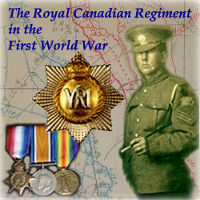
![]() The RCR in the Great War
The RCR in the Great War
![]() War Diary
War Diary
![]() Battle Honours
Battle Honours
![]() Battle Bars and The RCR
Battle Bars and The RCR
![]() The RCR Battle Bar Ledger (pdf)
The RCR Battle Bar Ledger (pdf)
![]() Honours and Awards
Honours and Awards
![]() Roll of Honour
Roll of Honour
![]() Prisoners of War
Prisoners of War
![]() Cemetery List
Cemetery List
![]() Cemetery Map
Cemetery Map
![]() Courts Martial
Courts Martial
![]() Officers
Officers
![]() RSMs of The RCR (1914-1919)
RSMs of The RCR (1914-1919)
![]() NCOs and Soldiers
NCOs and Soldiers
![]() An Officer's Diary (1914-1918)
An Officer's Diary (1914-1918)
![]() Recollections of a Nonagenerian (R. England) (1916-1919)
Recollections of a Nonagenerian (R. England) (1916-1919)
![]() On to Bermuda (1914-15)
On to Bermuda (1914-15)
![]() England and France 1915-1916 (Hayes; 1931)
England and France 1915-1916 (Hayes; 1931)
![]() Overseas with The Royals (1915)
Overseas with The Royals (1915)
![]() Regimental History Pamphlet (1917)
Regimental History Pamphlet (1917)
![]() Amiens (1918)
Amiens (1918)
![]() Cambrai (1918)
Cambrai (1918)
![]() Monchy-le-Preux (1918)
Monchy-le-Preux (1918)
![]() Under-aged Soldiers in The RCR
Under-aged Soldiers in The RCR
![]() Not All Were Volunteers; The RCR and the Military Service Act
Not All Were Volunteers; The RCR and the Military Service Act
![]() Sentenced to Death by Court Martial
Sentenced to Death by Court Martial
![]() The 7th Trench Mortar Battery
The 7th Trench Mortar Battery
![]() A Regimental Goat
A Regimental Goat
![]() Regiment and Family, Bermuda 1914-15
Regiment and Family, Bermuda 1914-15
![]() "March the Guilty Bastard In"
"March the Guilty Bastard In"
![]() Surrendered as Stowaway
Surrendered as Stowaway
![]() Re-Visiting the Great War Roll of Honour for The RCR
Re-Visiting the Great War Roll of Honour for The RCR
![]() Canadian Corps Trench Standing Orders (1916)
Canadian Corps Trench Standing Orders (1916)
